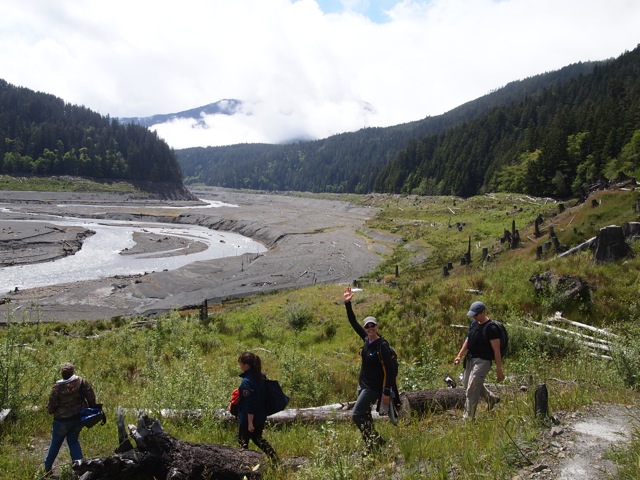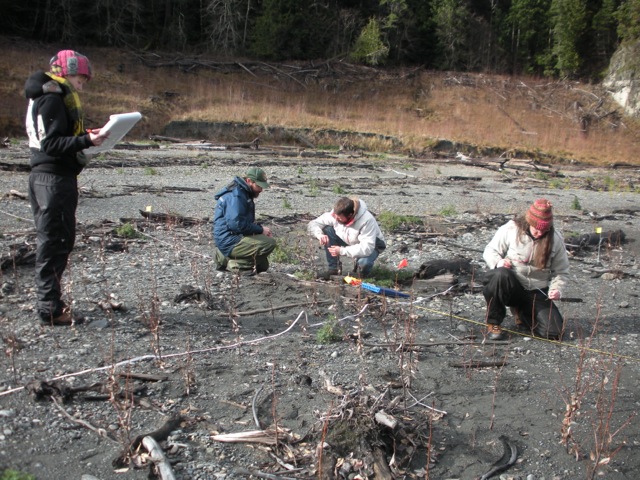
By Giovanni Roverso
Barbara Blackie, biology instructor at PC, is readying a new project assisting the Olympic National Park’s Elwha River restoration efforts and is seeking volunteers for spring quarter.
Blackie said that students interested in participating in the restoration for college credit can join Directed Studies or Directed Research courses at PC. She said most students take it for one or two credits and that the course can be taken up to three times. Some restrictions apply. More information can be found on PC’s Course Catalog or by contacting Barbara Blackie at bblackie@pencol.edu.
Olympic National Park’s Joshua Chenoweth, an ecologist and botanist in charge of the restoration project said the Plant Center is open to drop-in volunteers as well, from 9 a.m. to 4 p.m., Mondays and Wednesdays, “open to anybody.”
Since late 2012 Blackie and her students have been working closely with Chenoweth.“Our goal is to assist the Park and help them answer research questions they don’t have time to,” said Blackie. “Since this is cutting edge, new territory, their main goal is restoration, not research.”
Chenoweth said the restoration is on track. While project funding will run out in 2017, he suggested the college could continue to help the Park with monitoring for another ten years after the revegetation project is done.

A look back
Blackie’s students’ initial project which informally wrapped up in spring 2014, aimed at finding out whether using ectomycorrhizal fungi native to the Elwha River basin could significantly assist new tree development. Ectomycorrhizal fungi form mutually beneficial symbiotic relationships with plants at the root level and nestle in between the plant’s cells. They give plants an advantage by keeping them better hydrated and by providing extra nutrients such as nitrogen and phosphorus.
So, it was up to the college team to find out whether it was worth inoculating soil with the fungi. Blackie said Renée Reed, the first student to volunteer, began the background research and came up with a study design. People with the Park suggested which tree species to use—Douglas Fir and Grand Fir—and helped with the methods and design. The college team then proceeded to inoculate half of 300 saplings with native soil containing ectomycorrhizal fungi collected from around the Elwha.
This work was done at the Matt Albright Native Plant Center next to Robin Hill Park east of Port Angeles. The center was refitted specifically for the restoration project by the Park Service.
Later, Blackie said, when samples were taken from the tree pots it was found that some fungi spores had somehow made it to the non-inoculated pots as well, although a lesser amount of roots were covered in these. The 300 saplings were planted along the newly-exposed Elwha river banks.
Chenoweth said that preliminary findings showed the fungi had a significant effect only on the Grand Firs and hoped to observe the difference out in the field.
Unfortunately, over summer 2014 about 70% of the trees in most plots died from the drought. Few results have been collected as of yet. Blackie hopes to have students do so next spring or fall for the final report.

Looking Ahead
More recently Blackie has begun recruiting students for a new team and is hoping to get more on board soon. “The current project, looking at natural recruitment of Black Cottonwood began this quarter, winter 2015 and we hope to have all the data collected by the end of spring quarter,” Blackie said.
Chenoweth said the Park is interested in good statistics on the colonization extent and growth rate of the Black Cottonwoods particularly on two terrain types which were not previously thought to be hospitable. The trees seem to be populating surprisingly well on both fine-grained valley walls and gravelly cobble terraces created by released river sediment.
Blackie said another project of interest but for which there was no time was in researching positive effects of logs and large pieces of wood on seedling growth due to factors such as wind protection and moisture retention.
Chenoweth said the Park is still very interested in this and will have to take care of it, possibly with help from students of the University of Washington where Chenoweth got his master’s degree.
The future of the Matt Albright Native Plant Center, Chenoweth said, was an important part of the Park before the restoration so it should be afterward too. He also said the Park is responsible for lots of revegetation projects all over, including road and country revegetation.
Chenoweth said he would like to reach out to other federal agencies on the Peninsula and the region so as to provide plants for their projects. Some of these include the Department of Fish and Wildlife, and the Forest Service.
Furthermore, he said it would be nice to keep the greenhouse open to the college so as to further students’ horticultural experience.

this no late registration stuff is a bore… maybe there are exceptions for courses like these